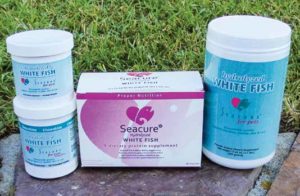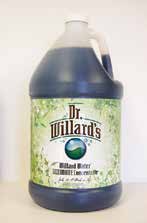Whole Dog Journal readers often try many of the techniques and products described in its pages. But sometimes years go by before we need something we read about, or it disappears from the market, or we have trouble finding it, or we simply forget all about it. Here are some favorite go-to products featured in previous issues that might now be perfect for you and your dog. If your dog thinks it’s the most exciting thing you’ve ever put in a bowl while you gag and hold your breath, it’s probably green tripe – raw, unprocessed stomach tissue from ruminants such as cows or sheep. Tripe fans claim that this stinky meat (think of rotting fecal matter) has multiple benefits for dogs who are lucky enough to receive it often. Twenty-five years ago, California resident Mary Voss lived in the Netherlands with her husband and their Afghan Hound. “All the old-time Dutch breeders fed green tripe to their dogs,” she says. “It was sold in stores and was easy to find, so that’s what we fed our dog, too.” But when they returned to the United States in 1990, the only tripe they could find was bleached, deodorized, and sterilized – not the same at all! Voss contacted farm and custom slaughterers and began collecting 60- to 100-pound cow stomachs which she cut, wearing rubber boots, rubber gloves, and a heavy duty butcher’s apron while wielding a hose, two buckets, and a large, sharp knife. By the 1990s, American dog owners were experimenting with raw food, thanks to books by veterinarians Richard Pitcairn, Ian Billinghurst, and Tom Lonsdale, along with other writers. “Sadly,” says Voss, “not many people credited or had even heard of Juliette de Bairacli Levy. It was from her books and old-time breeders in Europe that I learned about the benefits of raw food for dogs, especially the green tripe.” (See “Grandmother Nature,” July 2006 for our profile of Juliette de Bairacli Levy.) Voss shared her enthusiasm with fellow dog owners, starting a co-op that distributed raw frozen tripe from other sources. But quality was always a concern, so in 2003 she opened her own small factory in Hollister, California. “We started with a 1,000-square-foot unit,” she says. “We’re now in a 9,000-square-foot building with manufacturing, frozen storage, and dehydration areas, plus a store front and office.” Voss ships between 20,000 and 30,000 pounds of green tripe products every week to customers throughout the United States. Even after raw diets became popular in the U.S., green tripe was viewed with suspicion. “It was considered offal and was used only supplementally and only by ‘hard core’ raw feeders,” says Voss. “Over time that has changed. Many long-term raw feeders – those who had switched from kibble to raw with good results – were beginning to see health problems in their dogs. They grudgingly experimented with green tripe, and their dogs’ problems disappeared. Today green tripe is increasingly used as a staple food, and customers who formerly fed green tripe only two or three times a week now feed it five times a week if not every day, with the tripe replacing other raw ingredients. These customers report amazing results with their dogs.” Note: Tripe may be used as a major component of a home-prepared diet, but it is not nutritionally complete alone. Check the label of any commercial products you feed to see whether they are indicted for “intermittent or supplemental feeding” or are a “complete and balanced diet. Soon after our 2008 green tripe article was published, Mike Rowe visited GreenTripe.com as part of his “Dirty Jobs” program on the Discovery Channel. “We credit the Whole Dog Journal and Mike Rowe for the growth and success of GreenTripe.com,” says Voss, “as well as for educating people about how wonderful green tripe is for dogs, which was always our main goal.” Voss’s plant is USDA-inspected, and she sources all of her products from grass-fed and organically raised animals. “When users report disappointing results from green tripe, it’s almost always from grain-fed sources,” she says. “We also have calf tripe that is good for dogs with grass allergies.” NEW PRODUCTS In addition to ground green tripe in 1-, 2-, and 5-pound packages, Voss makes a number of new products: – Green Tripe with Trachea and Gullet (a natural source of chondroitin sulfate and recommended for dogs with hip or joint problems) – Xkaliber (green tripe, muscle meat, heart, tongue, trachea/gullet, and ground bone), recommended for younger dogs, serious working dogs, and when fed twice a week, older dogs – Tripe Organ Meat Blend (freshly frozen beef heart, lungs, liver, spleen, pancreas, and green tripe) – Whole cow gullets and tracheas – Raw cow hooves and tripe-stuffed raw cow hooves – K9-Magic (a cooked training treat roll containing muscle meat, green tripe, oat flour, garlic, thyme, coriander, parsley, vitamin C, and sea salt) – K9-Strips (dehydrated strips of green tripe, an ultimate chew treat) – K9-Krackle (dehydrated pieces of green tripe, perfect for training or show ring treats). These treats, by the way, are far less odoriferous than raw green tripe. – Voss’s newest products include: – Sheep Tripe (lamb tripe) – Sheep Tripe Blend (lamb tripe, heart, and tongue) – Sheep Organ Blend (lamb tripe, heart, tongue, and liver) – Calf Tripe Xkaliber (calf tripe, heart, tongue, and trachea) – Beef pancreas, which is offered for dogs with EPI (exocrine pancreatic insufficiency). For dogs with EPI, suggests Voss, “Feed 2 ounces of beef pancreas for every 20 pounds of body weight, whipped and served at room temperature, mixed with the dog’s regular food. We have some long-time customers who have been doing this for years while keeping their dogs in optimal health. The pancreas isn’t used as a food but more as a medicine, replacing Viokase, which is a powder vets usually prescribed for dogs and cats with EPI and that can have many side effects. Dogs and cats have done so well on raw pancreas that many vets all over the country now recommend it.” According to their owners, dogs with kidney disease, skin problems, puppy bone growth problems, irritable bowel disease, cancer, yeast infections, and a host of other health challenges have improved or had their lives saved by green tripe.

Sally Gutierrez of Long Beach, California, lives with four rescued dogs. Smokey, a 13-year-old black Chow-mix, suffers from elbow dysplasia, gastrointestinal problems, diarrhea, bronchitis, kidney disease, dilated cardiomyopathy (DCM), carbohydrate intolerance, and fat absorption problems. She says that green tripe from cows or sheep are the only foods that keep his symptoms under control. “Tripe is literally saving Smokey’s life,” she says. “His blood tests clearly show that when he eats anything other than tripe, everything changes, and when he’s back on the tripe, his tests are so much better. What’s really amazing is that he still bounds around and plays with the other dogs. I never, ever expected this outcome!” Jake, a 9-year-old Borzoi/German Shepherd-mix, has arthritis and hip dysplasia. He eats mostly sheep and beef green tripe with some Sheep Blend or Calf Xkaliber thrown in. Chief, a 7-year-old German Shepherd-mix, suffers from grass allergies and atopic dermatitis, which are kept in check by the Calf Tripe and Calf Xkaliber he eats daily. Skidoo, a 2-year-old blind and deaf double merle Australian Cattle Dog/Whippet/Mastiff-mix, also has atopic dermatitis. He eats sheep or beef green tripe daily with occasional Sheep Tripe Blend. “Thanks to green tripe,” says Gutierrez, “my dogs have an exceptional quality of life. Their physical and mental health are extraordinary given their ages. None of them need any prescription medication since the tripe keeps their symptoms under control so effectively. I even stock up on the GreenTripe.com product line to ensure that I will have enough food in case of disaster.” For more about green tripe’s benefits, feeding tips, and resources, see “Green Tripe: Old-Fashioned Wonder Food for Dogs,” July 2008. SEACURE Another food that humans find incredibly stinky but which most dogs love is a fish powder created 50 years ago by scientists at the University of Uruguay as they searched (under the direction of the United States National Academy of Sciences) for a way to feed starving children. The researchers fermented deep-sea whitefish fillets with marine microorganisms, then dried the biologically hydrolyzed fish to create a fine powder that has a long shelf life and requires no refrigeration. Physicians in Uruguay and adjacent countries used the formula to save the lives of thousands of premature, underweight, or malnourished infants. In clinical studies, these infants showed significant improvement in weight and immunity factors (globulin and gamma globulin levels) within 30 to 60 days. No premature infants receiving the fish formula developed edema, and it successfully treated other infants who developed edema, usually within 48 to 72 hours. Uruguayan researchers tested a combination of two-thirds mother’s milk and one-third fermented fish powder for premature infants and found that the fish powder improved assimilation and weight gain. The researchers reported a “most remarkable” disappearance of dysergia (lack of motor control due to defective nerve transmission) in cases of dystrophy. When given to pregnant women, the supplement helped prevent low-weight births. When it was fed to babies who were allergic to milk or other foods, their allergic reactions disappeared, along with acute and chronic diarrhea or blood-based immune disorders. Soon physicians were documenting health benefits for patients with all kinds of illnesses. Production stopped, however, after the death of the formula’s key developer. Donald G. Snyder, PhD, then director of the Fisheries Research Laboratory at the University of Maryland and a member of a U.S. National Research Council committee on protein supplements, formed a partnership to obtain the technology and produce the powder, which he named Seacure®. As it became available in the U.S. as a food supplement, dog lovers reported that Seacure sped the healing of wounds throughout the body, repaired digestive organs, alleviated nausea and vomiting, stopped diarrhea, prevented toxemia in pregnancy, rescued newborns from “fading puppy syndrome,” helped elderly dogs maintain their strength and stamina, helped all dogs recover from chronic and acute illnesses and surgery, stimulated hair growth, reduced the incidence of urinary tract infections, reduced or eliminated allergic reactions, prevented hot spots, improved mobility, reduced pain, and even enhanced the effectiveness of homeopathic and herbal remedies. Most protein supplements sold in the United States contain ingredients that can be difficult to digest and assimilate, such as meat, animal skins, milk, eggs, or soy. Dr. Snyder, who died several years ago, considered these proteins inferior sources for supplements. The World Health Organization established a model or ideal balance of the essential amino acids (isoleucine, leucine, lysine, methionine, cysteine, phenylalanine, tyrosine, threonine, tryptophane, and valine) in terms of milligrams of amino acid per gram of protein. The value of the protein provided by Seacure exceeds the model in every category. PET PRODUCTS When we featured Seacure in WDJ 10 years ago, Barry Ritz, who was then the marketing director at Proper Nutrition, Seacure’s manufacturer, explained, “It is no exaggeration to say that any dog of any age can benefit from Seacure’s high-quality protein.” Ritz credited Seacure with everything from improved wound healing to a thicker, glossier coat; a calmer disposition; improved digestion; and improvements in coordination, stamina, range of motion, and athletic performance.

Veterinarians and dog owners reported that doses of 6 to 12 capsules a day caused shaved fur to grow back in record time, broken bones and other wounds to heal quickly, and ailments like allergies, diarrhea, and inflammatory bowel disease to improve or completely disappear. Even dogs with autoimmune disorders like lupus regained their mobility and appetite. “Seacure also helps dogs with diabetic leg ulcers and other slow-healing wounds,” said Ritz. “It speeds recovery from surgery, wounds, and sports injuries. And dogs with arthritis or joint pain improve.” The only dogs for whom Seacure is not recommended are those whose phosphorus consumption should be severely restricted because of advanced kidney disease. (One gram of Seacure powder contains 21 mg phosphorus.) The levels of mercury contained in Seacure are below the threshold of detection in mercury toxicity tests, 0.01 parts per million. When our article appeared, Seacure was sold only in 500-mg capsules and Proper Nutrition had no plans to produce a powdered version for pets. That all changed when WDJ readers overwhelmed the company with orders. Soon Seacure was available as a powder for pets and then as a chewable training treat. But in recent years Seacure disappeared from the market. Dozens of online retailers carrying Seacure, including the manufacturer, continued to list the products but with “out of stock” or “not available” notices. As this article goes to press in August 2013, most of those notices remain in effect, though Proper Nutrition’s website is now selling the pet powder in its large size (500 grams, or slightly more than 1 pound) for $137.50. “We are in full production of the original formula and our complete pet product line will be available again soon. This includes the 100-gram powder, 500-gram powder, and chewable pet tabs,” says Proper Nutrition’s president Leonard Giunta, D.O. TIPS FOR USING SEACURE For more about Seacure’s health benefits for dogs, see “Securing Secure,” April 2003. The following tips and suggested amounts are a great starting point. To reduce its fishy odor, store Seacure in the freezer. For maintenance, adjust the label dosage to your dog’s weight (1/4 teaspoon of the powder for every 10 pounds of body weight per day, or 1 capsule per 20 pounds, or 1 of the Seacure Pet Tabs per 10 pounds of body weight). Seacure is nontoxic and can be given in quantities that exceed label doses. To help prevent toxemia in pregnancy, give at least the maintenance dose from breeding to whelping. For underweight or malnourished puppies, or to supplement a mother dog’s milk, mix Seacure with enough pure or filtered water to make a milk-like liquid and feed by dropper or nursing bottle. To prevent adverse symptoms of detoxification on fast days, when switching from commercial to home-prepared food, or when using herbs and supplements that support detoxification, give at least the maintenance dose. To help dogs recover from surgery, cuts, wounds, trauma injuries, or broken bones, give at least twice the maintenance dose. To treat digestive disorders, such as diarrhea, colitis, or irritable bowel disease, give at least 1/4 teaspoon per 10 pounds of body weight twice or three times per day between or just before meals. After symptoms subside, use the maintenance dose. In June 2006, we described Willard Water, a liquid concentrate that is added to water for drinking or topical application. Its manufacturer makes no medical claims beyond reporting that Willard Water may have anti-inflammatory or analgesic properties and that free-radical scavenger tests show it to be a powerful antioxidant – but its enthusiastic users report much more. In the 1960s, John Willard, PhD, a professor of chemistry at the South Dakota School of Mines, searched for a way to remove the sludge that plagued oil wells. He found it in a formula he had previously developed to remove soot from Pullman railcars, which he referred to as Catalyst Activated Water, or CAW. Willard began experimenting with the concentrate after treating himself with a dilute solution for an accidental burn when it was the only water at hand. It immediately eliminated his pain and the burn healed quickly without scarring. Soon friends and relatives were using diluted Willard Water to treat burns, scrapes, sprains, bruises, and other injuries. Farmers and gardeners discovered that plants treated with Willard Water needed less fertilizer and had better root structure, higher yields, and more foliage, even during drought conditions. Ranchers reported improvements in cattle within three weeks of switching to Willard Water, including improved digestion. Livestock raised on Willard Water showed greater resistance to shipping fever, caused by the stress of crowded transportation, as well as reduced stress during weaning, branding, dehorning, and castration. “REAL” WILLARD WATER In 1980 Willard Water was examined by a Congressional subcommittee on health and long-term care, investigated by the “60 Minutes” TV program, and tested by the U.S. Food and Drug Administration; each group found it to be safe and nontoxic. The scrutiny brought attention to the product, but the publicity had a downside: it encouraged so many imitators that Willard spent the rest of his life defending his patents against infringers. Charlie Sunde and his wife, Kolleen, own Nutrition Coalition in Fargo, North Dakota, a leading retail source for Willard Water. According to Charlie Sunde, Willard first developed what he called the “Clear Formula” of his catalyst-altered water. In an attempt to add nutrients extracted from lignite coal, which contains the fossilized remains of prehistoric vegetation, he then developed a formula he called XXX (or Triple X), which he regarded as valuable due to those nutrients but weaker in effect than the original Clear formula. Still later, he developed a formula now known as Ultimate (previously known as Dark XLR-8 Plus), which he considered equal in strength to the Clear and containing the minerals and nutrients he thought to be present in the Triple X. Recent studies published on the company’s website support Willard’s conclusions. In a test of nutrient absorption by plants, the Ultimate formula could be diluted four to eight times more than the Clear or XXX formulas and still perform as well as or better than either. Another study analyzed Willard Water’s ability to boost absorption of nutrients at the cellular level. “What’s especially interesting,” says Sunde, “is that it seemed most effective at increasing the most-difficult-to-absorb nutrients, which is in keeping with what Doc Willard always told us.” Another effect that sets Willard Water apart from other products, Sunde adds, is its ability to permanently improve the pH of water by making it more alkaline, which is said to have a beneficial effect on overall health. “Most ‘alkaline waters’ remain alkaline for only a matter of hours or days before they lose their increased alkalinity,” says Sunde. “A new study explains how water’s pH is permanently changed by Willard Water. I don’t think the study mentions this, but Doc actually tested some diluted Willard Water that was 15 years old and the pH was the same as when it was made.” All three formulas are still being sold, but Nutrition Coalition is the only source of the Ultimate (or Dark XLR-8 Plus) formula. “Doc wanted it that way,” says Sunde, “to protect his favorite formula from the problems less-than-ethical marketers had created with the Clear and XXX versions, and his sons and now his grandchildren have continued that arrangement. We are the only source of the Ultimate for stores that wish to carry it and the only distributor for retail sales other than the manufacturer, CAW Industries. Dealers can sell the Ultimate, but any firm or store selling the Ultimate has to get it from us.” One fluid ounce (2 tablespoons) of the concentrate per gallon of water is the strength recommended for daily human consumption as well as for topical application on pets and people. This same strength is a good daily drinking water for animals with acute or chronic health problems or for any animals during hot weather or times of stress. (Note that these recommendations are for Ultimate Willard Water. The greatly diluted Dark XXX product requires 2¼ times the amounts listed here.) Start with less than the recommended amount, and increase gradually. If your dog develops diarrhea or other symptoms of detoxification, reduce the amount until symptoms disappear and then resume as normal. The recommended maintenance water for healthy dogs, cats, and other animals not under stress is far more dilute, such as 1/3 ounce (2 teaspoons) concentrate per gallon of water. Use this solution to fill your dog’s water bowl, which should be available at all times. Also add it to dry, canned, or raw food. In her book Holistic Guide for a Healthy Dog, Wendy Volhard, another longtime user of Willard Water, recommends adding diluted Willard Water to your dog’s drinking water when traveling to keep stress levels under control. “Taking your own supply of drinking water is preferable,” she says, “but if that is not possible, use what is available on your trip and add 2 tablespoons of diluted Willard Water to each bowl, so that your dog is not affected by the change.” For our 2006 article, we interviewed Roger DeHaan, DVM, a holistic veterinarian in Kings Mountain, North Carolina, who has recommended Willard Water for his canine patients since 1983. He mixes the liquid concentrate with drinking water for improved hydration and applies it to cuts, wounds, and other injuries. He even adds a small amount (10 cc) of full-strength concentrate to each liter of Lactated Ringers Solution before administering subcutaneous fluids. To use Willard Water topically, dilute 2 teaspoons concentrate in 1 quart water or use 2 tablespoons per gallon. Use this solution as a wash or rinse to clean and treat cuts, burns, wounds, or abrasions. Pour it directly on the affected area or use a spray bottle. Repeat the application several times per day. Spray or apply it to sprains, bruises, trauma injuries, arthritic joints, and any area that is swollen or tender. Volhard swears by Willard Water as a hot spot treatment. “It dries up the inflamed areas overnight,” she says. “I also spray it on cuts to stop the bleeding and on insect bites to reduce the swelling and irritation.” To improve your dog’s coat, spray it with diluted Willard Water before brushing or grooming. Willard Water helps prevent dander, freshens the coat, and helps most dogs smell better. Increase the effectiveness of your dog’s shampoo by mixing 1/4 cup shampoo with 1 cup diluted Willard Water. According to users who reported their results to Dr. Willard, this actually helps calm excitable or nervous show animals. If you use a conditioner, which may no longer be necessary as Willard Water has a conditioning effect, mix it at the same proportions. Finish with a final rinse of dilute Willard Water solution or an herbal tea made with diluted Willard Water. To treat any eye condition, spray diluted Willard Water directly into the dog’s eye. Willard Water helps clear up conjunctivitis and other infections, and it’s an effective first-aid rinse for the removal of debris. Clear Willard Water concentrate is often recommended for use in the eyes, but many users report excellent results from rinsing or spraying eyes with dark Willard Water solutions. If desired, add a pinch of unrefined sea salt to make the solution slightly salty. Tears are saline, and adding a small amount of salt makes the solution more comfortable. Whenever you brush your dog’s teeth or give her a tooth-cleaning rope toy to chew on, spray the toothbrush or toy with diluted Willard Water. Diluted Willard Water can be used as an ear cleaner, too, or you can add a few drops of full-strength concentrate to any liquid ear cleaner. Willard Water helps the solution reach farther and loosen wax and debris. Nutrition Coalition also sells Aqua Gel, a blend of Willard Water, aloe vera, and vitamin E for topical application on burns, insect bites or stings, bruises, sore muscles, skin conditions like eczema or psoriasis, and hot spots; Chinota Gel, a blend of Willard Water and Chinese herbs for muscle aches and arthritis pain; and Very Natural Willard Water Soap made with Willard Water, olive oil, coconut oil, and glycerin. This non-irritating bar soap is a favorite of most who try it. For more about Willard Water’s many uses, see “Willard Water,” June 2006. CJ Puotinen, author of The Encyclopedia of Natural Pet Care and other books, is a frequent contributor to WDJ. She and her husband live in Montana with Chloe (black Lab), Seamus (Cairn Terrier), and a red tabby cat.
Charlie Sunde and his wife, Kolleen, own Nutrition Coalition in Fargo, North Dakota, a leading retail source for Willard Water. According to Charlie Sunde, Willard first developed what he called the “Clear Formula” of his catalyst-altered water. In an attempt to add nutrients extracted from lignite coal, which contains the fossilized remains of prehistoric vegetation, he then developed a formula he called XXX (or Triple X), which he regarded as valuable due to those nutrients but weaker in effect than the original Clear formula. Still later, he developed a formula now known as Ultimate (previously known as Dark XLR-8 Plus), which he considered equal in strength to the Clear and containing the minerals and nutrients he thought to be present in the Triple X. Recent studies published on the company’s website support Willard’s conclusions. In a test of nutrient absorption by plants, the Ultimate formula could be diluted four to eight times more than the Clear or XXX formulas and still perform as well as or better than either. Another study analyzed Willard Water’s ability to boost absorption of nutrients at the cellular level. “What’s especially interesting,” says Sunde, “is that it seemed most effective at increasing the most-difficult-to-absorb nutrients, which is in keeping with what Doc Willard always told us.” Another effect that sets Willard Water apart from other products, Sunde adds, is its ability to permanently improve the pH of water by making it more alkaline, which is said to have a beneficial effect on overall health. “Most ‘alkaline waters’ remain alkaline for only a matter of hours or days before they lose their increased alkalinity,” says Sunde. “A new study explains how water’s pH is permanently changed by Willard Water. I don’t think the study mentions this, but Doc actually tested some diluted Willard Water that was 15 years old and the pH was the same as when it was made.” All three formulas are still being sold, but Nutrition Coalition is the only source of the Ultimate (or Dark XLR-8 Plus) formula. “Doc wanted it that way,” says Sunde, “to protect his favorite formula from the problems less-than-ethical marketers had created with the Clear and XXX versions, and his sons and now his grandchildren have continued that arrangement. We are the only source of the Ultimate for stores that wish to carry it and the only distributor for retail sales other than the manufacturer, CAW Industries. Dealers can sell the Ultimate, but any firm or store selling the Ultimate has to get it from us.” One fluid ounce (2 tablespoons) of the concentrate per gallon of water is the strength recommended for daily human consumption as well as for topical application on pets and people. This same strength is a good daily drinking water for animals with acute or chronic health problems or for any animals during hot weather or times of stress. (Note that these recommendations are for Ultimate Willard Water. The greatly diluted Dark XXX product requires 2¼ times the amounts listed here.) Start with less than the recommended amount, and increase gradually. If your dog develops diarrhea or other symptoms of detoxification, reduce the amount until symptoms disappear and then resume as normal. The recommended maintenance water for healthy dogs, cats, and other animals not under stress is far more dilute, such as 1/3 ounce (2 teaspoons) concentrate per gallon of water. Use this solution to fill your dog’s water bowl, which should be available at all times. Also add it to dry, canned, or raw food. In her book Holistic Guide for a Healthy Dog, Wendy Volhard, another longtime user of Willard Water, recommends adding diluted Willard Water to your dog’s drinking water when traveling to keep stress levels under control. “Taking your own supply of drinking water is preferable,” she says, “but if that is not possible, use what is available on your trip and add 2 tablespoons of diluted Willard Water to each bowl, so that your dog is not affected by the change.” For our 2006 article, we interviewed Roger DeHaan, DVM, a holistic veterinarian in Kings Mountain, North Carolina, who has recommended Willard Water for his canine patients since 1983. He mixes the liquid concentrate with drinking water for improved hydration and applies it to cuts, wounds, and other injuries. He even adds a small amount (10 cc) of full-strength concentrate to each liter of Lactated Ringers Solution before administering subcutaneous fluids. To use Willard Water topically, dilute 2 teaspoons concentrate in 1 quart water or use 2 tablespoons per gallon. Use this solution as a wash or rinse to clean and treat cuts, burns, wounds, or abrasions. Pour it directly on the affected area or use a spray bottle. Repeat the application several times per day. Spray or apply it to sprains, bruises, trauma injuries, arthritic joints, and any area that is swollen or tender. Volhard swears by Willard Water as a hot spot treatment. “It dries up the inflamed areas overnight,” she says. “I also spray it on cuts to stop the bleeding and on insect bites to reduce the swelling and irritation.” To improve your dog’s coat, spray it with diluted Willard Water before brushing or grooming. Willard Water helps prevent dander, freshens the coat, and helps most dogs smell better. Increase the effectiveness of your dog’s shampoo by mixing 1/4 cup shampoo with 1 cup diluted Willard Water. According to users who reported their results to Dr. Willard, this actually helps calm excitable or nervous show animals. If you use a conditioner, which may no longer be necessary as Willard Water has a conditioning effect, mix it at the same proportions. Finish with a final rinse of dilute Willard Water solution or an herbal tea made with diluted Willard Water. To treat any eye condition, spray diluted Willard Water directly into the dog’s eye. Willard Water helps clear up conjunctivitis and other infections, and it’s an effective first-aid rinse for the removal of debris. Clear Willard Water concentrate is often recommended for use in the eyes, but many users report excellent results from rinsing or spraying eyes with dark Willard Water solutions. If desired, add a pinch of unrefined sea salt to make the solution slightly salty. Tears are saline, and adding a small amount of salt makes the solution more comfortable. Whenever you brush your dog’s teeth or give her a tooth-cleaning rope toy to chew on, spray the toothbrush or toy with diluted Willard Water. Diluted Willard Water can be used as an ear cleaner, too, or you can add a few drops of full-strength concentrate to any liquid ear cleaner. Willard Water helps the solution reach farther and loosen wax and debris. Nutrition Coalition also sells Aqua Gel, a blend of Willard Water, aloe vera, and vitamin E for topical application on burns, insect bites or stings, bruises, sore muscles, skin conditions like eczema or psoriasis, and hot spots; Chinota Gel, a blend of Willard Water and Chinese herbs for muscle aches and arthritis pain; and Very Natural Willard Water Soap made with Willard Water, olive oil, coconut oil, and glycerin. This non-irritating bar soap is a favorite of most who try it. For more about Willard Water’s many uses, see “Willard Water,” June 2006. CJ Puotinen, author of The Encyclopedia of Natural Pet Care and other books, is a frequent contributor to WDJ. She and her husband live in Montana with Chloe (black Lab), Seamus (Cairn Terrier), and a red tabby cat.
WILLARD WATER
Available from Nutrition Coalition, Fargo, ND. (800) 447-4793; WillardsWater.com (note the “s” in the url).






